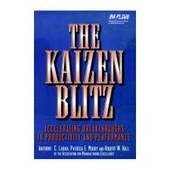Dec 6 2013
Confusion Over Standards: Limits or Basis for Innovation? | Industry Week Blogs | Jeffrey Liker
See on Scoop.it – lean manufacturing
“As an undergraduate engineering student I spent a term in the offices of a nuclear power company writing standards. I sat at a desk, with a typewriter, and nuclear engineers fed me information while I wrote the standards. Standard 300.47.3.1. I had never been to a nuclear power site and had no idea what I was writing about, and I am pretty certain nobody at the site had memorized the tens of thousands of standards. They were aimed at the Nuclear Regulatory Commission who audited the company so we could prove we were safe. To the best of my knowledge pieces of paper never prevented a nuclear crisis.”
Jeffrey Liker chimes in on the issue of standards. While efforts to clear up the confusion on this topic in the context of Lean are praiseworthy, I think the terminology of “Standardized Work,” and “Work Standards” itself is hopeless.
Every author uses them differently, there is no hope of achieving consistency, and the word “standard” comes with too much undesirable cultural baggage, as illustrated by Jeffrey’s anecdote quoted above. As a result, every discussion of this topic is Tower-of-Babel project review.
Just because Toyota in the US uses terms doesn’t mean we have to, as they often are mistranslations of its own, Japanese terms, which themselves are not necessarily clear.
That’s why I prefer to talk about “work combos” for specifying how different tasks performed at different stations are combined into an operator job that fills the takt time, and “work instructions” for the breakdown of each task into steps with key points.
Then we can reserve the word “standard” for external mandates and internally generated rules and protocols used, for example, in quality problem-solving with suppliers.
See on www.industryweek.com


Dec 11 2013
John Shook – #Lean Production Meets #LeanStartup | Mark Graban’s notes
See on Scoop.it – lean manufacturing
 Blog post at Lean Blog : After their recent recorded conversation, it was great to see John Shook, CEO of LEI, and Eric Ries, Author of The Lean Startup together on[..]
Blog post at Lean Blog : After their recent recorded conversation, it was great to see John Shook, CEO of LEI, and Eric Ries, Author of The Lean Startup together on[..]
The Lean Enterprise Institute’s John Shook shared the stage with “Lean Startup” author Eric Ries at a conference in San Francisco.
I was wondering whether Shook would in any way endorse Ries’s ideas as having anything to do with Lean. Mark’s notes show no evidence of that. It seems that Shook essentially explained his background at Toyota and NUMMI.
“The Lean Startup” is a good read. The ideas are reasonable, plausible, and well explained, including the “Minimum Viable Product” (MVP) and “pivoting.” In fact, they have taken root in the vocabulary of software entrepreneurs, at least here in Silicon Valley.
But are they, in any way, related to Lean?
See on www.leanblog.org
Share this:
Like this:
By Michel Baudin • Blog clippings 12 • Tags: Lean, Lean Startup, Ries, Shook